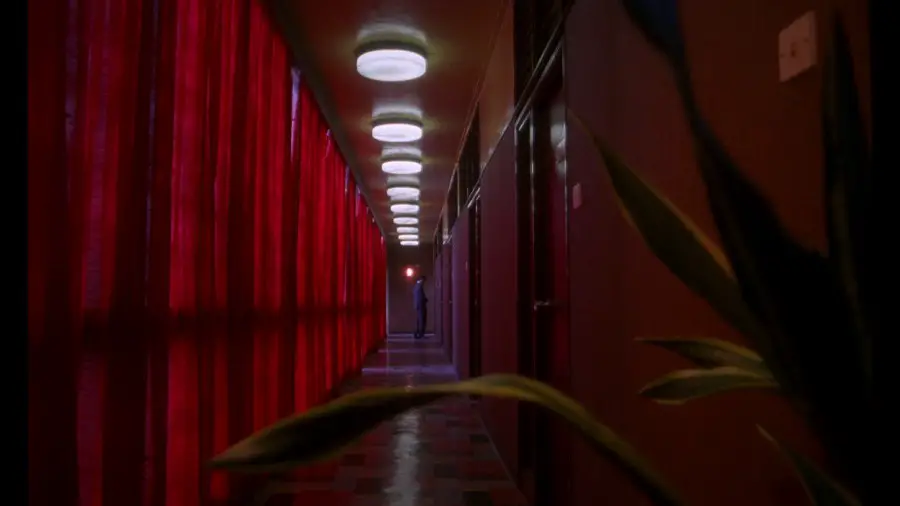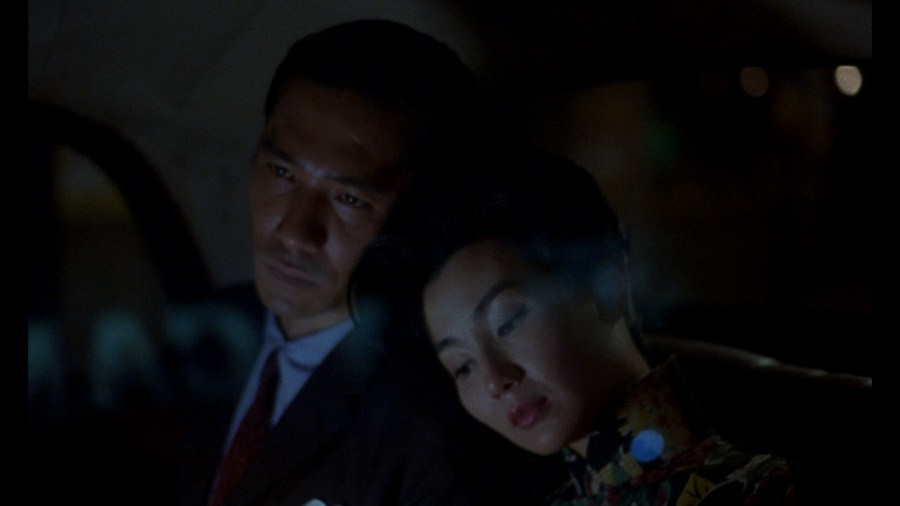In the Mood for Love

See more details, packaging, or compare
Synopsis
Hong Kong, 1962: Chow Mo-wan (Tony Leung Chiu-wai) and Su Li-zhen (Maggie Cheung Man-yuk) move into neighboring apartments on the same day. Their encounters are formal and polite—until a discovery about their spouses creates an intimate bond between them. At once delicately mannered and visually extravagant, Wong Kar-wai’s In the Mood for Love is a masterful evocation of romantic longing and fleeting moments. With its aching musical soundtrack and exquisitely abstract cinematography by Christopher Doyle and Mark Lee Ping-bin, this film has been a major stylistic influence on the past decade of cinema, and is a milestone in Wong’s redoubtable career.
Picture 8/10
Wong Kar-wai’s In the Mood for Love receives a Blu-ray upgrade from Criterion and is presented in its original aspect ratio of 1.66:1 on this dual-layer disc. The new high-definition transfer is presented in 1080p/24hz.
In the Mood for Love is a gorgeous looking film and this high-def presentation certainly does it well. There are softer looking moments that I feel are more stylistic choices on the part of the director, but past these moments the image is sharp and cleanly defined. Patterns on Maggie Cheung’s dresses come through clearly, and the colours, primarily fall-like colours like reds, oranges, and browns, are rendered beautifully with no distortion or noise around the edges. Film grain is present and fairly clean, but some darker areas of the screen can look a little noisy. Other than these few moments I couldn’t detect any other artifacts.
The print is clean, with only a few miniscule blemishes remaining, including what looks like dirt on the lens of the camera. As a whole it’s a nice upgrade over the previous Criterion DVD and delivers a very film-like presentation.








































Audio 7/10
The Blu-ray comes with an upgraded DTS-HD MA 5.1 surround track. One of the first noticeable improvements is the addition of the LFE channel; the Criterion DVD was actually missing this channel, effectively delivering a 5.0 surround track (still not sure why.) The addition of the LFE channel does offer some noticeable improvements with the bass, but in terms of activity the track doesn’t appear to differ too much.
The track is still front heavy with most everything, from dialogue to music and sound effects, sticking to the front three speakers. There’s noticeable panning and movement but nothing spectacular. The surrounds really only kick in with some background effects, like rain hitting the ground or rooftops around, and music near the end also fills out the environment. But otherwise everything, including most of the film’s score, sticks to the fronts, dialogue heavily to the center.
But this appears to be the film’s sound design and it suits the film. Audio quality is excellent, clear and distinct, the film’s score especially impressive. It won’t show off anything but again it’s appropriate to the film.
The 2.0 track found on the DVD is not available here.
Extras 9/10
The Blu-ray moves most everything over from the 2-disc DVD, though some items didn’t make it. Criterion at least added some new stuff to try and make up for that.
The first feature would be the making-of documentary called @In the Mood for Love. Through interviews, behind-the-scenes footage, and a lot of clips from the film, this 51-minute documentary covers the film’s production in a fairly extensive manner. We get to see a lot of the development of the film, which, as one can see, was mostly spontaneous and made up as they went (somewhat frustrating to Maggie Cheung apparently.) The actors talk about developing their characters, who changed as production went on, and as a bit of a treat we get to see some deleted footage, showing how things were constantly dropped by the director. Disappointingly the documentary doesn’t get into the rather lengthy amount of time it took to make the film, or some of the strife that occurred because of constant changes and reshoots or for political reasons. Still, you at least get an idea of the frantic shoot and also come away with a better understanding of Wong Kar-wai’s style.
Deleted scenes are next on the list, and we get four of them, three of which come with an optional commentary by director Wong Kar-wai with English subtitles. The commentary features the director talking about shooting the scenes and why they were altered. The scenes resemble some sequences in the finished film, but do contain moments not found in it. Some of them could even be described as alternate sequences. A couple of the scenes would have appeared more than likely in the mid-section of the film while the other two would have taken place after the film ended, including a sequence where the two main characters meet again. I like the scenes but in some cases I’m glad they were cut as a couple of them would alter the film enough, and I doubt it would have had the same impact on me. But again they show just how the director really wings it as it he goes. In total they run about 33-minutes.
Next is a short film (about 2 and a half minutes to be precise) by Kar-wai called Hua Yang de Nian Hua. It's actually a montage of footage used nitrate film stock found at a defunct theater in Chinatown in Hollywood. Wong Kar-wai took footage from these films displaying some of Hong Kong's forgotten actresses. It’s a lovely little tribute and I was surprised by the overall condition of the footage.
Two segments featuring Wong Kar-wai are next, both recorded in 2001, starting with a 22-minute English interview featuring the director talking, or meandering, about the film (and 2046), starting with the reason for the lengthy delay in production (an economic crisis played a big part in this,) and then talking about the subject matter of the film, the use of food to indicate the seasons/months, locations, and his involvement in getting the look he wants. This is followed by a 16-minute “Cinema Lesson” given by Wong at the Cannes Film Festival, where the director talks about his various films and their production histories. Both are excellent additions offering insights into the problematic production and yet again the director’s style.
Criterion next delivers a press conference from the Toronto International Film Festival as put together by Roger’s Television, running about 43-minutes, and features Tony Leung and Maggie Cheung (apparently Wong could not attend.) Asked a series of questions by the moderator and members of the press the two talk about the film’s beginnings, the lengthy production, what it was like to work for Wong, their characters, and the overall style. It can be a bit dry (like a lot of press conferences) but worth watching just to get the perspective of the two actors.
On In the Mood for Love is a new interview with critic Tony Rayns, recorded specifically for this Blu-ray release. In it Rayns goes over Wong’s career in the 90s and the production history of In the Mood for Love, which started out as a film called Summer in Beijing, changed to a humourous 60s period piece, and then morphed into the film we get now, which was basically shot twice after the director found a better location. Rayns also explains why the locations are so limited (there isn’t much left of old Hong Kong,) talks about the film’s style, the actors, and members of the crew. He also looks at his various films and how they relate, and how In the Mood for Love places in his work. Some of this material is scattered about in the other features on the disc, but it’s nice to get a straight-forward, concise discussion.
Somewhat updated for this release is the soundtrack section. This section first features an 8-minute interview with Rayns yet again, who talks about the film’s score, the various songs that appear, giving brief histories and descriptions. You also get a sampling of the music, 12 pieces in total, from the film. Presented in 2.0 Dolby Digital, they play over a static shot from the film. Some of the material sounds rough but it’s great getting most everything from the film here.
The supplements then conclude with various trailers and TV spots, including one of each for the Hong Kong, U.S., and French markets.
The booklet carries over from the DVD the short story “Intersection”, which influenced the film’s storyline. Not carried over are notes by Li Cheuk-to, general manager of the Hong Kong International Film Festival. Also missing, inexplicably, is a short statement by the director about the film. The booklet does feature a new essay by Steve Erickson, who looks at this film and Days of Being Wild.
Though Tony Rayns’ interviews seem to act replace them, a few features are missing that were on the DVD. The DVD presented a multimedia essay by Joanna Lee that went over the music in the film, allowing the viewer to jump to a section of the film featuring the music being discussed. There was also a text essay by composer Michael Galasso about the film’s score, and then finally a short note by Wong. Other text features are also missing, including a lengthy essay written by film scholar Gina Marchetti on Hong Kong in the 60s and how it influenced Wong Kar-wai, , and then another fairly lengthy piece about the director’s career and his various films. A photo gallery is also gone as are biographies for the various members of the cast and crew. Again Rayns’ interviews cover some of this material, but not to the extent the text essays did on the DVD. I’m not sure why Criterion feels the need to replace or redo their text features as they have always offered some wonderful material and I think these were great.
Overall the material is strong and still holds up well, offering a look into the making of the film and the director’s body of work as a whole. But I do miss the text features found on Criterion’s original DVD, which got into more detail about certain aspects of the film than Rayns’ serviceable interviews do.
Closing
Though some features have been replaced with material not as strong, or removed entirely, the supplements still offer a compelling look into the making of the film. But the transfer, which offers a more filmic presentation, makes the upgrade worthwhile. It comes with a strong recommendation.







